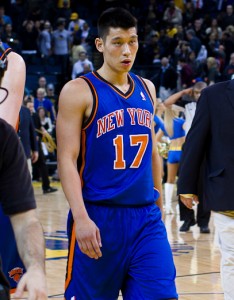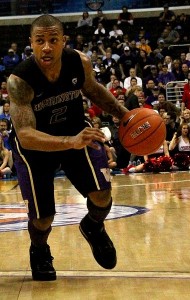Fantasy Basketball Primer Part 2 – H2H, Roto and Keeper League Strategies
Last week, I introduced you to the Sheridan Hoops Fantasy Primer, where you will learn how to use league settings to your advantage, separate the right players from the wrong ones and prepare for your draft. Today, let’s look at strategies specific for Head-to-Head, Rotisserie and Keeper leagues.
Head-to-Head versus Rotisserie
Notice that I omitted Points leagues. They are great for novices and passive players, but there is limited tactical challenge in Points leagues. The main strategy is to simply draft the best player. Roto and H2H leagues offer the additional challenge of achieving that winning balance across the scoring categories, a focal point of this piece.
 Role of Luck
Role of Luck
One big difference between Head-to-Head and Rotisserie leagues is the far greater influence of luck in H2H. Instead of determining the winner on a sample of 25 weeks of play, H2H leagues instead tally a series of very small one-week samples.
Ultimately, the winner in H2H is determined in a two-week sample of essentially meaningless games where half the teams in the NBA are sitting their best players, either to rest them for the playoffs or in an effort to actually lose the game.
The randomness of small samples affects not only your team’s statistical tally but also your weekly opponent’s. You can have a great week and still lose or an awful one and win. The timing of these absurd weeks often determines who makes the playoffs and who doesn’t. They also largely dictate success in the playoffs. This large additional influence of luck in H2H narrows the gap between the best teams and the worst and dulls the impact of having superior players. This is can be very frustrating, but in a glass-half-full way, it adds to the challenge.
Importance of Balance
The key to success — in both formats — is balance. You have to be able to compete in all categories in order to win. Punting a category guarantees a loss, but the hoped-for offsetting gain in other categories is far from absolute. The reverse is also true. You shouldn’t try to win any category either. There is no benefit to winning a category by more than one point. A balanced team that competes in all categories and wins none maximizes the efficiency of all of the stats your team collects during the season. In addition, you will have far more flexibility and in season tactical options with a balanced roster.
The key to building a balanced team is avoiding category killers and having redundancy, both positionally and across scoring categories. A category killer is someone who will have a detrimental effect on a particular category, typically a percentage or rate statistic that can go up or down like FT%. For example, Dwight Howard is a category killer because of his FT% — not only is it low, but he will also lead your team in FTA, which means his low FT% will carry a greater weight than any high-percentage shooter can offset. Redundancy allows you to overcome the inevitable injuries or bad years and gives you options for both making trades and waiver wire additions.
You can never forget that the fantasy game is inherently unpredictable — players get hurt or have bad years; others may perform better than you expected. If you do not have sufficient redundancy or are stuck with a category killer, you lose the ability to adjust when (not if) misfortune strikes. Again, the reverse applies, if you lead the league in assists and the opportunity arises to acquire a top point guard (say the next Jeremy Lin) you will either pass up the opportunity or the impact of that addition will be minimal.
The best way to address balance is at the draft table when you have a full choice of relatively equal options. Some try to build an imbalanced team in the draft with a view to trading their way out of it, but this is only a means to weakening your overall talent level, because it is hard to make fair trades in fantasy.
The draft or auction process effectively ensures that players land with the owner who values them the most. Therefore, in order to trade you almost always have to be prepared to give more than you are acquiring. It’s even harder to trade if your team is unbalanced, because it limits who you can trade, who you can trade with and gives your trade partner additional leverage in the negotiation because he knows your imbalances.
Punting and Consistency
Many fantasy pros will generally highlight two tactics for H2H leagues compared to Roto: punting and consistency. Don’t listen to them. Build your H2H team as you would a Roto style team.
Punting, which is sacrificing one or two categories every week in the hope of getting better than average results in the other categories, is a sucker’s strategy and actually hurts your team more in H2H than in Roto. The reason is, you are almost guaranteed of losing your punted category every week but the expected increased performance in the other categories is less likely to happen because of the larger influence of luck discussed above. It is also much harder to win your match-up if you are giving your opponent a head start. Lastly, when you punt you reduce your tactical options to take advantage of your opponent’s weaknesses. I will discuss this in more detail shortly.
 Consistency is preferring players with smaller game-to-game variations in their output instead of ones that tend to run hot and cold. This is probably a more prevalent phenomenon in fantasy baseball than fantasy basketball, but the groupthink goes along the lines that a more consistent performer will contribute above-average performance in more weeks than an inconsistent one.
Consistency is preferring players with smaller game-to-game variations in their output instead of ones that tend to run hot and cold. This is probably a more prevalent phenomenon in fantasy baseball than fantasy basketball, but the groupthink goes along the lines that a more consistent performer will contribute above-average performance in more weeks than an inconsistent one.
The statistical studies I have seen actually say the opposite. Guys who get white-hot can win you weeks singlehandedly and when they go cold, don’t prevent you from winning. My approach is to ignore consistency, just take the guy who will get most stats for you regardless of when they tend to get them.
Long Term versus Short Term
In Roto leagues you have the luxury to take the long view and not worry about week-to-week fluctuations. Thus, an important principle for Roto league managers is mean reversion — the likelihood that a player’s performance will return to its historical norm and thus the old adage of buy low and sell high.
In H2H on the other hand, you must think more short-term and tactically, i.e. try to win all categories that are close every week. The hot hand becomes more valuable to you than the player likely to revert to the mean.
Another important point to note for H2H is that once a week is complete you have no chance to adjust your standing. You start anew every week. Plus the H2H season ends 4 weeks earlier (due to playoffs) than a Roto season. Therefore, early season stats are much more important in H2H. You should downgrade all players who are starting the season hurt or with minimal playing time, even if they may have a bigger impact in the second half.
H2H Specific Tactics
In H2H you should try to take every point you can; here are some tactics to facilitate that. First of all, if your opponent is punting a category, go get a quick lead in that category, book the win, and then adjust your roster to compete in the other categories. (You can’t do this if you are the one who is doing the punting.)
Second, if a category is close and you can win it merely by replacing a couple of players on your roster who are not playing for a couple who are, go do it. You will be surprised how small the gap is between the guy you drop and the available talent on the wire. The outsized impact of all of these small wins will add up over the course of the season. This is especially true in shallow leagues.
Third, try not to spend roster spots on players who are not playing or are not contributing. Over a 25-week Roto season, a couple of missed games played is unlikely to change anything, especially since you have time to make up the losses. However, in a single week match-up, a couple of DNP’s will have a huge impact on your results and you have no chance to make that production back up.
Lastly, if your opponent is a mad streaming demon (i.e., is constantly adding and dropping players trying to maximize games played) and your league uses a lot of Rate categories, take the Rate categories he is giving you — an advantage for preferring efficient over volume players — build your lead there then get ahead of him by streaming players for the next day.
For example, you have your lead and it is Thursday. Your opponent is fully loaded with guys playing on Friday. Go ahead and stream players who are playing on Saturday. This will both allow you to compete for the counting stats and will also frustrate him, since you got all the good options for Saturday and he has to use worse ones.
Another way to improve your odds in H2H is to maximize diversity among the NBA teams that your players play for. The reason for this is scheduling. If you have too many players from the same team, you will have fewer options for rotating players in and out of the starting lineup because they all have the same off days. You may also be subject to periodically harder schedules or fewer games played in a week. Lastly, some NBA teams always surprise, either to the upside or the downside. Diversity limits your potential exposure to the negative surprises and maximizes your exposure to the upside surprises.
Keeper versus Non-Keeper Leagues
Another piece of information that may surprise you is that it’s actually easier to win keeper leagues than non-keeper leagues. Intuitively, the extra complexity of keeper leagues (and playing against owners who are committed for the long term) leads to the thought that winning keeper leagues should be more difficult than non-keeper leagues.
This is not true, because every keeper league has a couple of owners who are perpetually thinking about next year and not this year. They load up on rookies or injured players and are quickly unconcerned with current year results. These ‘next year I will be unstoppable’ types reduce the number of teams you are actually competing against and also represent great trade partners. They are usually willing to pay a premium to add youth and long term upside. Therefore, success in keeper leagues often depends on simply trying to win the current year — even if you get off to a poor start. As Woody Allen said, 80% of success in life is just showing up.
 The logical flaw of the ‘next year’ players is that they under-appreciate the wide variance of results from year to year and the fact that the further out you try to project results, the greater the margin for error.
The logical flaw of the ‘next year’ players is that they under-appreciate the wide variance of results from year to year and the fact that the further out you try to project results, the greater the margin for error.
The success rate of player forecasts for the upcoming season is already much less than you would expect; when you try to lookout beyond one season it gets exponentially worse. I am sure plenty of owners projected big things for Derrick Rose or Ricky Rubio for the 2012-13 season at the start of the 2011-12 season, only to see their hopes dashed by injury. They are probably already thinking about 2013-14 and planning on investing a high draft pick on the next Hasheem Thabeet.
In addition, players with more current-year value than long-term value can be acquired at a significant discount. This discount repeats every year. For example, last week I talked about Marquis Teague and how he will be drafted before Kirk Hinrich in keeper leagues because of his long term value. This doesn’t mean that I recommend you draft Marquis Teague over Kirk Hinrich in keeper leagues. Hinrich can be acquired at a cheaper cost than Teague and is likely to outperform him this year.
The one hitch to the strategy is, after multiple years of competing, how do you acquire those elite talents that win leagues? The answer is back to luck and aging veterans. Despite the preponderance of scouting information, some of the best players often emerge out of nowhere. Luck will allow you to stumble into these players, especially if you are focused on the near-term opportunity presented to the player instead of consensus views on a player’s talent. For example, if you were thinking next year, would you have dropped Jimmer Fredette for Isaiah Thomas before a competitor who was trying to win that year?
Also, elite players usually become elite because of a superior desire and work ethic. That desire and work ethic doesn’t fade with age and often allows them to defy their age. How long have you been avoiding or steeply discounting Kobe Bryant, Steve Nash and Kevin Garnett in keeper leagues based on your perception that they only have a year or two more left? These types of players are frequently not kept or can be traded for at a steep discount.
Lastly, as hard as it to believe, there will be another hotshot rookie coming into the league next year. So, there are no missed opportunities to get younger.
Next week in Part 3, I take a look at common rule settings and how you can best exploit them.
HI, i am looking to create an elimination league in which was introduced to me through a recent article i have read. Would you mind further explaining the format necessary to have a successful one through the entire season?
Hi Jesse, it was my article on Roto elim, here: http://sheridanhoops.com/2012/10/01/fantasy-spin-october-1-2012/
You could try it with 12 teams and eliminate one each month, but we like starting with 20 and eliminating two each month. The commish does need to do a few extra things on the 1st and 2nd of each month. They are outlined in that article, but if you need more explanation, let me know.